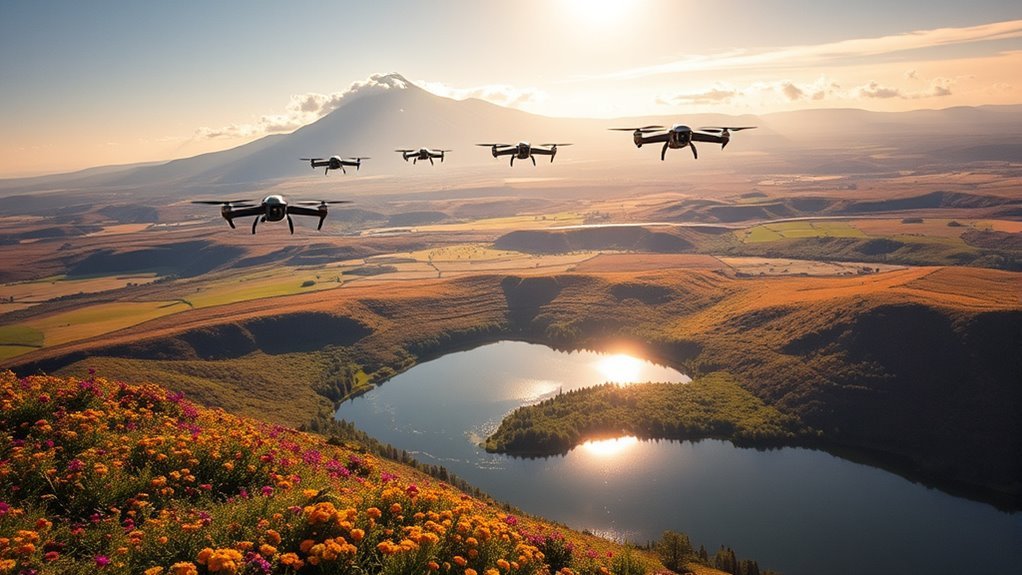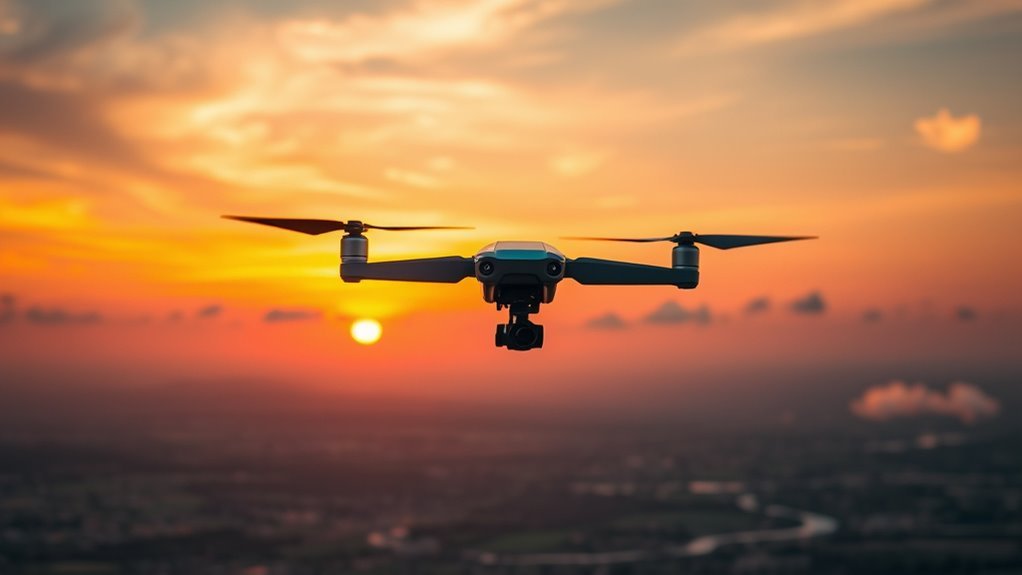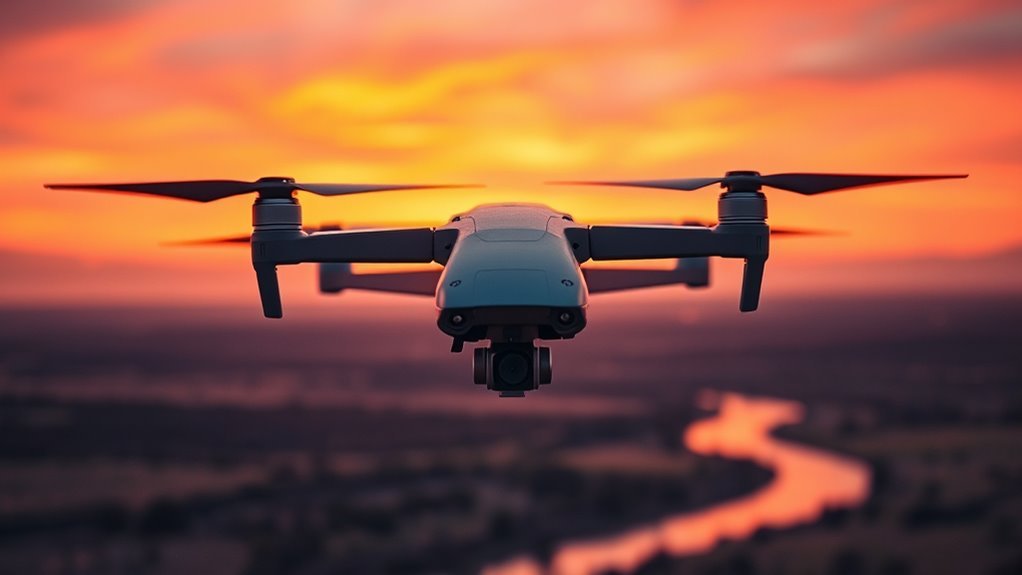Drones typically fly between 5 to 60 minutes, depending on various factors like battery capacity, weight, and environmental conditions. Lightweight drones, such as racing models, may only last 5-10 minutes, while professional photography drones can achieve 30-40 minutes. Battery health and maintenance also play critical roles in flight duration. Understanding these nuances can enhance your drone experience and guarantee peak performance. Discover further insights into maximizing your drone’s flight time and efficiency.
Factors Affecting Drone Flight Time

When considering how long a drone can stay airborne, several key factors come into play. Propeller efficiency is essential; the design and material of your drone’s propellers directly impact lift and overall performance. Efficient propellers maximize thrust while minimizing energy consumption, enabling longer flight times. Additionally, altitude effects cannot be overlooked. As you ascend, air density decreases, which can reduce propeller effectiveness and increase energy demands. This means that flying at higher altitudes may shorten flight duration unless your drone is specifically designed for such conditions. Understanding these factors allows you to optimize your drone’s performance, ensuring you can enjoy the freedom of flight for as long as possible while maneuvering both propeller efficiency and altitude challenges. Moreover, battery capacity plays a crucial role in determining how long a drone can remain airborne, as higher capacity batteries provide extended flight times. Furthermore, aerodynamic design can significantly enhance flight efficiency, reducing drag and conserving energy for longer durations.
Understanding Battery Capacity

The performance of a drone is greatly influenced by its battery capacity, which determines how long it can operate before needing a recharge. Understanding this capacity is essential for maximizing your drone’s efficiency and flight time. Here are some key factors to take into account:
The battery capacity significantly impacts drone performance, dictating flight duration and efficiency.
- Battery Lifespan: Regularly monitor your battery’s health to guarantee it maintains optimum performance. Additionally, maintaining a high power efficiency in your drone’s design can further extend flight times.
- Charging Techniques: Employ proper charging methods to extend battery life, such as avoiding overcharging and using compatible chargers.
- Capacity Ratings: Familiarize yourself with mAh ratings, as they directly correlate with how long your drone can fly.
Additionally, larger battery capacities, like that of the Autel EVO Lite+ V2, provide extended flight times, enhancing operational independence.
The Impact of Weight on Flight Duration

Weight plays an essential role in determining a drone’s flight duration, as even a small increase can noticeably affect performance. When you add weight to your drone, whether through a camera or other equipment, it directly impacts the power required for flight. This increased demand on the battery can shorten flight time considerably. Additionally, proper weight distribution is important; uneven weight can lead to instability and inefficient energy use, further diminishing flight duration. Understanding your drone’s payload capacity is critical; exceeding it can lead to decreased performance and potential damage. Ultimately, by optimizing your drone’s weight and its distribution, you can maximize flight efficiency, allowing for longer durations and enhancing your operational freedom in the skies. Notably, the Freefly Astro Prime offers a flight time of up to 25 minutes under optimal conditions, showcasing the importance of balancing weight and battery performance. Furthermore, environmental factors like wind and altitude can also challenge lifting performance, impacting flight duration.
Weather Conditions and Their Influence
Adding equipment to your drone isn’t the only factor that can impact flight duration; weather conditions also play a significant role. Understanding how these elements interact can help you optimize your flying experience. Here are some specific influences to take into account:Weather conditions significantly affect drone flight duration, alongside added equipment—understanding this interplay can enhance your flying experience.
- Wind Resistance Effects: Strong winds can increase drag, causing your drone to consume more battery power.
- Temperature Fluctuations: Extreme heat or cold can affect battery efficiency, leading to reduced flight times.
- Precipitation and Humidity: Rain and high humidity can add weight and hinder performance, further shortening your flight duration. Additionally, environmental conditions such as high altitude can decrease lift and drain power faster.
Types of Drone Batteries
Various types of drone batteries can greatly influence flight duration and overall performance. The two most common battery types are lithium polymer (LiPo) and nickel metal hydride (NiMH). LiPo batteries are favored for their lightweight design and high energy density, allowing for longer flights. Conversely, NiMH batteries provide a more stable discharge rate but are heavier and bulkier, which can impact maneuverability. Proper battery management practices are essential for maximizing their lifespan.
| Battery Type | Key Features |
|---|---|
| Lithium Polymer | Lightweight, high energy density |
| Nickel Metal Hydride | Stable discharge, heavier design |
| Lithium Polymer | Fast charging capabilities |
| Nickel Metal Hydride | Longer lifespan with proper care |
Understanding these differences helps you choose the right battery for your drone, enhancing your flying experience.
Flying Techniques for Maximizing Flight Time
To maximize your drone’s flight time, you need to focus on efficient battery management and ideal flight conditions. Understanding how to conserve battery life through power settings and flight patterns can greatly enhance performance. Additionally, flying in favorable weather conditions can further extend your drone’s operational duration. For instance, drones like the DJI Mavic 3 Enterprise are designed with high-density lithium-polymer cells that optimize power usage, allowing for extended flight times. Utilizing 5.1K video resolution can also help in reducing the overall weight of equipment, leading to improved flight efficiency.
Efficient Battery Management
While effective battery management is crucial for extending drone flight durations, employing specific flying techniques can greatly enhance overall performance. You can considerably improve your drone’s efficiency by integrating the following practices:
- Gentle Maneuvers: Avoid sudden changes in direction or altitude to conserve energy.
- Altitude Control: Fly at ideal altitudes to minimize resistance and maximize battery life.
- Weight Management: Keep your drone lightweight by minimizing unnecessary attachments and equipment.
Additionally, employ battery optimization techniques, like following proper charging protocols, to guarantee your batteries maintain peak performance. Regularly monitor battery health and cycle counts to extend their lifespan. With these strategies, you’ll maximize your drone’s flight time, giving you the freedom to explore more with every flight.
Optimal Flight Conditions
Effective battery management and flying techniques lay the groundwork for enhancing flight conditions. To maximize flight time, aim for an ideal altitude, typically between 100 to 400 feet. This height minimizes air resistance while still allowing for stable GPS connectivity. Additionally, consider environmental factors such as wind speed and temperature. Flying in calm conditions not only conserves battery life but also enhances control. Avoid sudden maneuvers; instead, adopt smooth, gradual movements to reduce energy consumption. Utilize flight modes that promote efficiency, like ‘loiter’ mode, which can help maintain altitude with minimal power usage. By integrating these strategies, you can considerably extend your drone’s operational capacity, allowing you to explore further and enjoy the freedom of flight.
Maintenance Tips for Longer Flight Durations
Maintaining your drone is essential for maximizing flight durations, as even minor neglect can lead to significant performance issues. By following a few key maintenance practices, you can guarantee your drone operates efficiently and effectively.
- Regular drone cleaning: Remove dirt and debris that can affect aerodynamics and weight.
- Firmware updates: Keep your drone’s software up to date to improve performance and battery management.
- Battery care: Store and charge batteries properly, avoiding extreme temperatures and overcharging. Additionally, implementing automated inspections can help ensure that your drone remains in optimal condition, thereby enhancing its overall performance and longevity.
Different Drone Models and Their Flight Times
When selecting a drone, understanding the flight times associated with different models is essential, as these durations can considerably affect your intended use and overall experience. Drone categories vary widely, and so do their flight times. Here’s a quick flight comparison of popular models:
| Drone Model | Flight Time (minutes) |
|---|---|
| Mini Drones | 10-20 |
| Racing Drones | 5-10 |
| Photography Drones | 20-30 |
| Professional Drones | 30-40 |
| High-End Drones | 45-60 |
These flight comparisons can guide your decision-making process, ensuring that you choose a model that aligns with your freedom of use and personal needs. Understanding these differences empowers you to make an informed choice. Additionally, factors like battery performance can significantly influence flight durations, highlighting the importance of selecting a drone with suitable specifications for your missions. Many high-end models, such as the DJI Mavic 3 Pro, offer impressive flight times and advanced features, making them ideal for serious aerial photography enthusiasts.
Real-World Examples of Flight Durations
Although manufacturers provide estimated flight times for various drone models, actual performance can differ greatly based on factors such as payload, weather conditions, and pilot experience. In real-world applications, these variables can considerably impact flight durations. For instance:
- Commercial Delivery Drones: Often achieve around 30-40 minutes under ideal conditions, but can drop to 20 minutes with heavy payloads. The precise sensor calibration in delivery drones can help optimize their flight paths for improved efficiency.
- Agricultural Drones: Typically fly for 20-30 minutes, depending on battery life and terrain challenges. High-resolution imaging capabilities enhance the effectiveness of agricultural mapping during these flight durations.
- Cinematography Drones: May last 25-30 minutes, but wind can reduce this by up to 10 minutes. Effective power management is essential for optimizing battery usage and extending overall flight time.
These examples illustrate how industry standards vary, reflecting the need for pilots to adapt and enhance their operations based on specific conditions to achieve the best performance.
Future Innovations in Drone Flight Time
As advancements in battery technology and energy management systems continue to evolve, the potential for greatly extending drone flight times is becoming increasingly feasible. Innovations in autonomous technology are paving the way for smarter drones that can optimize their energy usage during flight. For instance, integrating energy harvesting capabilities allows drones to recharge while in operation, using solar power or kinetic energy from their movement. This synergy between autonomous systems and energy harvesting not only enhances endurance but also broadens operational horizons. As these technologies mature, you’ll find drones capable of longer missions, greatly reducing downtime and increasing efficiency. Additionally, a focus on safety protocols ensures responsible operation as flight times increase. The future holds exciting possibilities, empowering you to explore and utilize aerial capabilities like never before, fostering greater freedom in diverse applications.
Frequently Asked Questions
How Can I Improve My Drone’s Aerodynamics for Longer Flights?
To improve your drone’s aerodynamics, focus on streamlined drone design and weight reduction. Utilize lightweight materials and refine the shape to minimize drag, allowing for extended flight times and enhanced performance in various conditions.
What Are the Best Practices for Storing Drone Batteries?
Did you know that improper battery storage can reduce lifespan by up to 30%? For maximum battery maintenance, store them at a cool temperature, ideally between 20-25°C, to guarantee longevity and performance during flights.
Can Flying at Night Affect Battery Life?
Night flying can indeed affect battery efficiency. Colder temperatures at night may reduce battery performance, leading to shorter flight times. It’s essential to monitor conditions and adjust your usage to maximize your drone’s battery life.
How Does Altitude Impact Drone Flight Duration?
Altitude affects your drone’s flight duration profoundly. Higher altitudes can reduce flight efficiency due to thinner air, impacting lift and battery consumption. Understanding altitude effects helps you optimize your drone’s performance and extend your flying time.
Are There Apps to Monitor Drone Battery Performance?
Imagine your drone’s battery as a heartbeat. You can use apps for battery monitoring and performance tracking, ensuring ideal health. These tools empower you to fly longer, giving you the freedom to explore further.

